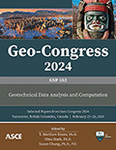Estimating Critical Velocity for High-Speed Rail
Publication: Geo-Congress 2024
ABSTRACT
This paper summarizes 3D geo-dynamic modeling work performed by Jacobs as part of assessing track embankment stability and ground response under dynamic loading from the high-speed train proposed for use on the California High-Speed Rail (CHSR) Project. The advanced numerical modeling technique was benchmarked with the well-known critical velocity case study site at Ledsgård, Sweden, using linear, equivalent-linear, and full non-linear soil models. The advantages and limitations of the modeling techniques are highlighted, with other design approaches and methodologies also briefly discussed based upon the experience of the Jacobs design team on other high-speed rail projects. This work shows that understanding the practical geotechnical management of Rayleigh waves is still under development. It requires a change away from normal geotechnical methods of static loading toward the use of methods appropriate for repeated loading conditions and the management of dynamic response.
Get full access to this article
View all available purchase options and get full access to this chapter.
REFERENCES
Alves Costa, P., R. Calçada, A. Silva Cardoso, and A. Bodare. 2010. “Influence of soil non-linearity on the dynamic response of high-speed railway tracks.” Soil Dynamics and Earthquake Engineering 30, 221–235.
Araujo, N. M. F. 2011. High-speed trains on ballasted railway track: dynamic stress field analysis. PhD Dissertation, Universidade do Minho, Portugal.
Dong, K., D. P. Connolly, O. Laghrouche, P. K. Woodward, and P. Alves Costa. 2019. “Non-linear soil behaviour on high-speed rail lines.” Computers & Geotechnics 112, 302–318.
Duley, A. 2018. Soil parameters for modelling critical velocity effects of railways. EngD Thesis, University of Southampton, UK.
Duley, A. 2021. “Practical geo-dynamic assessment of high-speed rail earthworks on the Align contract (High Speed 2).” Ground Engineering Nov. 2021.
Foti, S., F. Hollender, and F. Garofalo. 2018. “Guidelines for the good practice of surface wave analysis: a product of the InterPACIFIC project.” Bulletin of Earthquake Engineering 16 (6), 2367–2420.
Fryba, L. 1972. Vibrations of solids and structures under moving loads. Third edition. London, UK: Thomas Telford.
Houbrechts, J., M. Schevenels, G. Lombaert, G. Degrande, W. Rucker, V. Cuellar, and A. Smekal. 2011. “RIVAS Deliverable D1.1: Test procedures for the determination of the dynamic soil characteristics”., European Commission.
Itasca Consulting Group, Inc. 2019. FLAC3D – Fast Lagrangian Analysis of Continua in Three-Dimensions, Ver. 7.0, Minneapolis: Itasca.
Kausel, E., J. Estaire, and I. Crespo-Chacon. 2020. “Proof of critical speed of high-speed rail underlain by stratified media.” Proceedings of the Royal Society A476:20200083, https://doi.org/10.1098/rspa.2020.0083, 1–13.
Kaynia, A. M., C. Madshus, and P. Zackrisson. 2000. “Ground vibration from high-speed trains: prediction and countermeasure.” Journal of Geotechnical & Geoenvironmental Engineering 126 (6), 531–537.
Kenney, J. 1954. “Steady-state vibrations of beam on elastic foundation for moving load.” Journal of Applied Mechanics 76, 359–364.
Krylov, V. V. 1995. “Generation of ground vibrations by superfast trains.” Applied Acoustics 44, 149–164.
Kyrkou, K., M. Frost, P. Fleming, and N. Sartain. 2022. “The application of seismic surface wave testing on stiff low-height embankments for the construction of high-speed railway’s earthworks: a case study in the UK”. Proc. 11th Int. Symposium on Field Monitoring in Geomechanics, London, UK.
Madshus, C., and A. M. Kaynia. 2000. “High-speed railway lines on soft ground: dynamic behavior at critical train speed.” Journal of Sound and Vibration 231 (3), 689–701.
Madshus, C., and A. M. Kaynia. 2001. “High-speed trains on soft ground: track-embankment-soil response and vibration generation.” In Noise and vibration from high-speed trains. Krylov ed. London, UK: Thomas Telford.
Seed, H. B., and I. M. Idriss. 1970. “Soil moduli and damping factors for dynamic response analyses.”, Earthquake Engineering Research Center, University of California, Berkeley.
Sheng, X., C. J. C. Jones, and M. Petyt. 1999. “Ground vibration generated by a load moving along a railway track.” Journal of Sound and Vibration 228 (1), 129–156.
Shih, J. Y., D. J. Thompson, and A. Zervos. 2017. “The influence of soil nonlinear properties on the track/ground vibration induced by trains running on soft ground.” Transportation Geotechnics 11, 1–16.
WinSASW. 2002. WinSASW, Version 2.0 User’s Guide, Data Interpretation and Analysis for SASW Measurements, Department of Civil Engineering, Chung-Ang University, Anseong, Korea.
Woldringh, R. F., and B. M. New. 1999. “Embankment design for high-speed trains on soft soils.” In Geotechnical Engineering for Transportation Infrastructure, Barends et al., eds. Rotterdam, NL: Balkema.
Woodward, P. K., O. Laghrouche, S. B. Mezher, and D. Connolly. 2015. “Application of coupled train-track modelling of critical speeds for high-speed trains using three-dimensional non-linear finite elements.” International Journal of Railway Technology 4 (3), 1–35.
Information & Authors
Information
Published In
History
Published online: Feb 22, 2024
ASCE Technical Topics:
- Business management
- Continuum mechanics
- Dynamic loads
- Dynamics (solid mechanics)
- Engineering fundamentals
- Engineering mechanics
- Geotechnical engineering
- High-speed rail
- Infrastructure
- Management methods
- Models (by type)
- Numerical models
- Practice and Profession
- Rail transportation
- Railroad tracks
- Railroad trains
- Solid mechanics
- Structural dynamics
- Transportation engineering
Authors
Metrics & Citations
Metrics
Citations
Download citation
If you have the appropriate software installed, you can download article citation data to the citation manager of your choice. Simply select your manager software from the list below and click Download.
